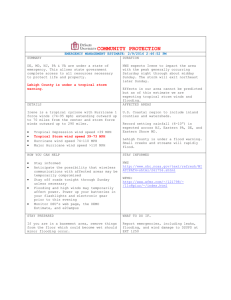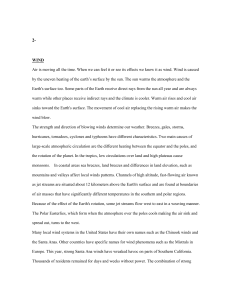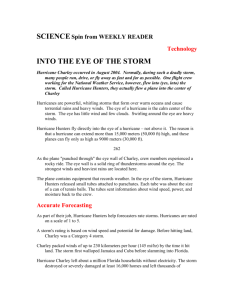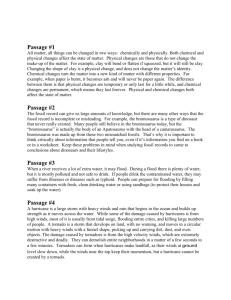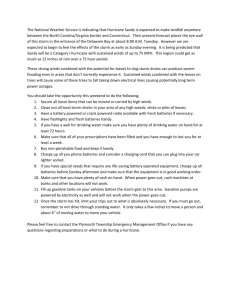GLOBAL WEATHER HIGHLIGHTS
advertisement
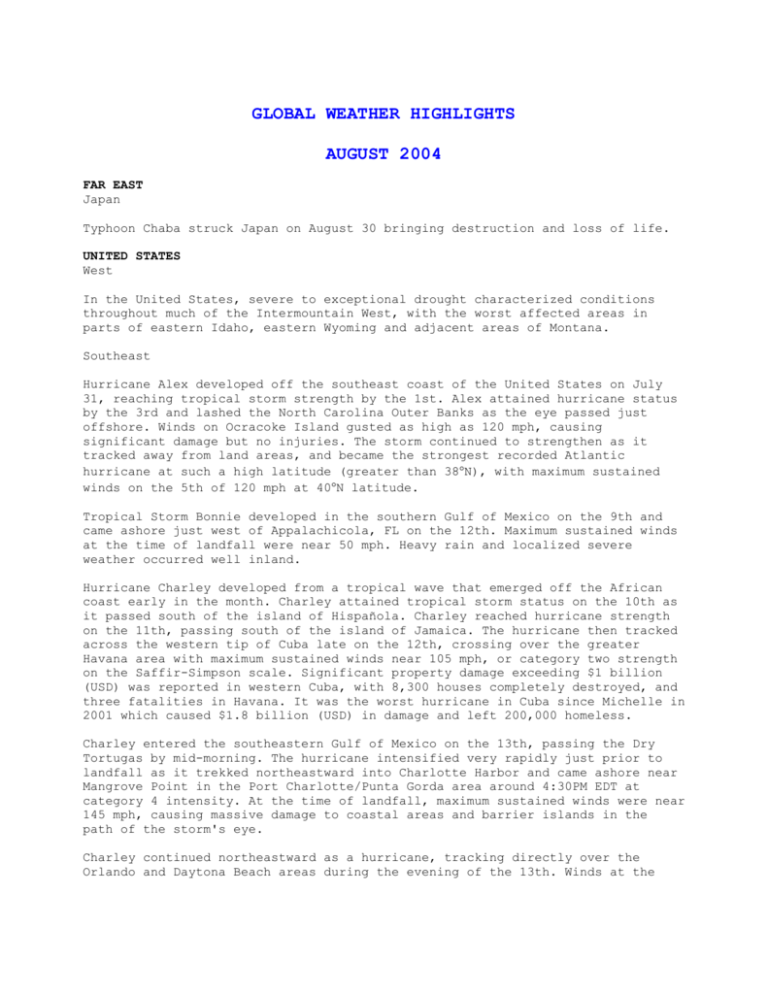
GLOBAL WEATHER HIGHLIGHTS AUGUST 2004 FAR EAST Japan Typhoon Chaba struck Japan on August 30 bringing destruction and loss of life. UNITED STATES West In the United States, severe to exceptional drought characterized conditions throughout much of the Intermountain West, with the worst affected areas in parts of eastern Idaho, eastern Wyoming and adjacent areas of Montana. Southeast Hurricane Alex developed off the southeast coast of the United States on July 31, reaching tropical storm strength by the 1st. Alex attained hurricane status by the 3rd and lashed the North Carolina Outer Banks as the eye passed just offshore. Winds on Ocracoke Island gusted as high as 120 mph, causing significant damage but no injuries. The storm continued to strengthen as it tracked away from land areas, and became the strongest recorded Atlantic hurricane at such a high latitude (greater than 38N), with maximum sustained winds on the 5th of 120 mph at 40N latitude. Tropical Storm Bonnie developed in the southern Gulf of Mexico on the 9th and came ashore just west of Appalachicola, FL on the 12th. Maximum sustained winds at the time of landfall were near 50 mph. Heavy rain and localized severe weather occurred well inland. Hurricane Charley developed from a tropical wave that emerged off the African coast early in the month. Charley attained tropical storm status on the 10th as it passed south of the island of Hispañola. Charley reached hurricane strength on the 11th, passing south of the island of Jamaica. The hurricane then tracked across the western tip of Cuba late on the 12th, crossing over the greater Havana area with maximum sustained winds near 105 mph, or category two strength on the Saffir-Simpson scale. Significant property damage exceeding $1 billion (USD) was reported in western Cuba, with 8,300 houses completely destroyed, and three fatalities in Havana. It was the worst hurricane in Cuba since Michelle in 2001 which caused $1.8 billion (USD) in damage and left 200,000 homeless. Charley entered the southeastern Gulf of Mexico on the 13th, passing the Dry Tortugas by mid-morning. The hurricane intensified very rapidly just prior to landfall as it trekked northeastward into Charlotte Harbor and came ashore near Mangrove Point in the Port Charlotte/Punta Gorda area around 4:30PM EDT at category 4 intensity. At the time of landfall, maximum sustained winds were near 145 mph, causing massive damage to coastal areas and barrier islands in the path of the storm's eye. Charley continued northeastward as a hurricane, tracking directly over the Orlando and Daytona Beach areas during the evening of the 13th. Winds at the Orlando International Airport gusted to 105 mph, a new record wind gust for the city. In Florida, 25 of the state's 67 counties were declared federal disaster areas. Tens of thousands of buildings were damaged, 12,000 destroyed and more than 2 million customers were without electrical services at the conclusion of the storm. The Florida citrus crop sustained severe damage. It was the strongest hurricane to hit Florida's west coast since Donna in September 1960, and it was the strongest hurricane to affect the state of Florida or the United States coastline since Hurricane Andrew in August 1992. Estimated insured losses from Charley were $7 billion (USD), while total economic loss was estimated at nearly $15 billion (USD). Charley was blamed for 22 deaths. Southeast and mid-Atlantic Tropical Storm Gaston developed off the southeast coast of the United States on the 27th, making landfall near McClellanville, South Carolina on the 29th just under hurricane strength, with maximum sustained winds near 70 mph. The storm moved northward, and dumped as much as 13 inches of rainfall on the city of Richmond, Virginia. This quantity of rainfall caused massive flooding in the city, and about 20 blocks of the downtown area was declared uninhabitable on the 31st. There were 5 fatalities in the greater Richmond area, and Virginia governor Mark Warner declared a state of emergency. ASIA Across South Asia, millions of residents were displaced by flooding in early August, with the Indian states of Assam and Bihar the worst-affected. Throughout India, Nepal and Bangladesh, around 1,800 deaths were blamed on flooding brought about by heavy monsoon rains since the beginning of June 2004. Tropical Depression Malou developed in the western Pacific Ocean off the coast of Japan on the 4th and tracked across the southern part of the country on the 5th before dissipating. Locally heavy rains fell as the depression moved across the region. Typhoon Rananim developed in the Philippine Sea on the 7th and reached typhoon strength by the 10th. Rananim moved into eastern China's Zhejiang province on the 12th with maximum sustained winds near 105 mph. This was the strongest typhoon to affect Zhejiang province since 1997, and killed at least 164 people while injuring 1,800. Rananim also caused an estimated $2.2 billion (USD) in economic losses. Typhoon Megi developed in the western Pacific Ocean on the 14th and tracked through the Korea Strait on the 18th with maximum sustained winds near 75 mph. Megi was blamed for 9 flooding deaths in Japan. Typhoon Aere developed in the eastern Philippine Sea on the 19th, reaching typhoon strength on the 21st. Aere affected the southern islands of Japan on the 23rd, tracked along the north coast of Taiwan during the 24th-25th before making landfall in southeast China's Fujian province on the 25th. Maximum sustained winds at the time of landfall in China were 75 mph. Flooding and landslides were blamed for more than 40 deaths in Taiwan, the Philippines, Japan and China. Typhoon Chaba developed in the western Pacific Ocean on the 18th, reaching super-typhoon strength 150 mph by the 22nd. Chaba struck Japan on the 30th with maximum sustained winds near 75 mph. Chaba was responsible for 13 deaths, flooded 13,000 homes and cut off electricity to more than 340,000 households. AFRICA eastern The March-May rainy season was shorter and drier than normal across parts of the Greater Horn of Africa, resulting in a continuation of multi-season drought in this region. In Somalia, more than 600,000 people were directly affected by the current drought and in need of food aid. South Heavy rains produced flooding in Cape Town around the 9th. At least 15,000 people were affected by the flooding, with many of those displaced from their homes. INDIA In Sri Lanka, more than a half-million families were affected by a severe drought that had damaged crops and left people without drinking water. EUROPE In Hungary, flooding at the beginning of August collapsed houses and forced dozens of people to leave their homes in the eastern part of the country. Heavy rains in the United Kingdom southward into France was responsible for localized flooding during August 16-19. A landslide trapped 57 motorists on a road in Scotland, while flash flooding devastated the tourist village of Boscastle. The rainfall was due in part to the remnants of Tropical Storm Bonnie that had affected the United States a week earlier. Strong thunderstorms swept across London on the 3rd causing flooding which temporarily closed down sections of the city's underground train system. One person was killed and four were injured by lightning. CANADA Cold weather in Canada's prairie provinces resulted in widespread frost across parts of Saskatchewan and Manitoba. It was the earliest widespread frost since 1992 and produced damage to crops in parts of the nation's breadbasket.
